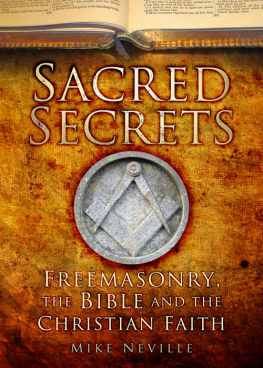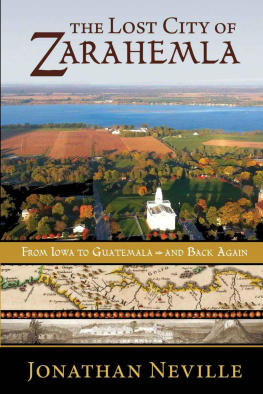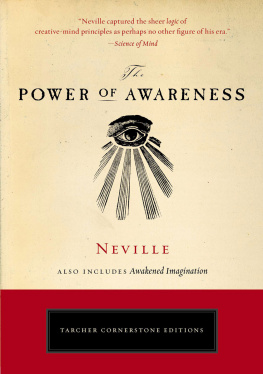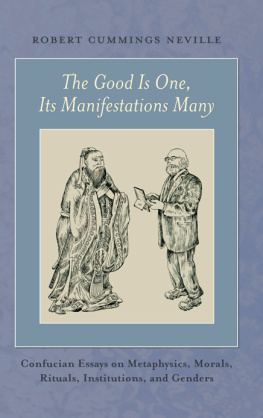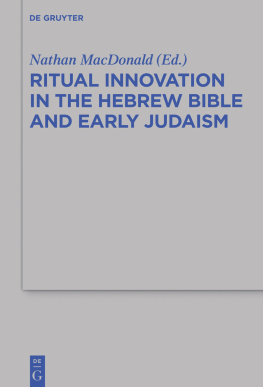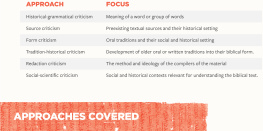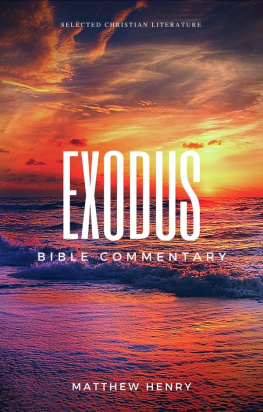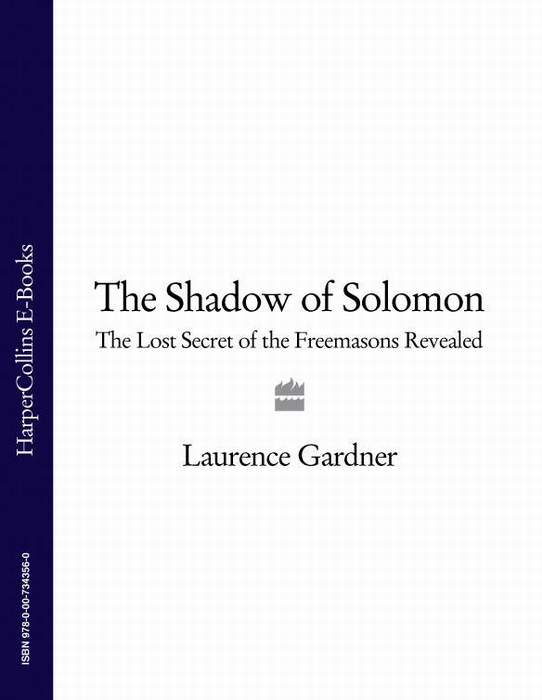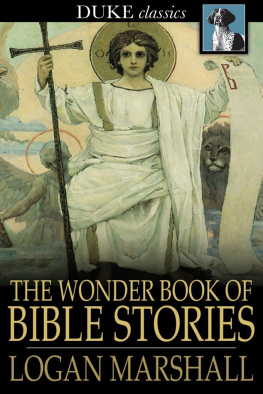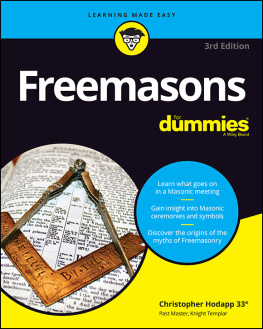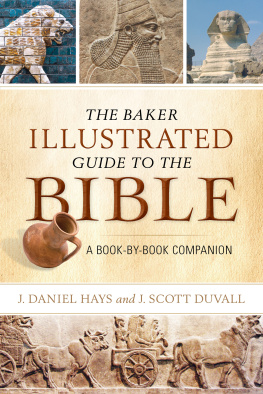C ONTENTS
B Y T HE R EVD N. B. C RYER , M.A. P AST G RAND C HAPLAIN
The value of this book will soon be obvious to anyone, man or woman, who joins the Freemasons or who is interested in knowing about their ceremonies. In the 17th and 18th centuries when these ceremonies were being formed, there were renewed interest in, and knowledge about, the Bible that had now been translated into English. Those ceremonies were made up of constant references to names, places and events which a member of the Society still has to memorise and repeat as he or she progresses in membership. As this book will reveal, there is an astonishing amount of Bible information that is shared.
In an age such as the present when familiarity with the contents of the Bible is nothing like as common as it was once, the newcomer to our ceremonies and their stories needs help to understand just what it is that is being referred to. To know about the background to the people and places that are mentioned helps the member to learn more easily the facts he or she has to repeat. I can well understand the benefit that the contents of this book can offer. It may also surprise the interested outsider to know how much of the Bible is still used and required by Freemasons. I have the greatest delight in wishing both this books author and its readers well.
The Revd N. B. Cryer, M.A. Past Grand Chaplain
1
When Freemasons join a lodge, an Ancient Charge is recited to them, giving the basic rules of the Order and advice on how to serve God, their country and their fellow men. The new Mason is directed to a serious contemplation of the Volume of the Sacred Law. Whilst this could be the Koran or other holy book, in Western Europe, North America and Australasia, this will invariably be a King James Version of the Bible, open and in full view of all lodge members.
After the Third Degree, some lodges present a Bible to the candidate and so the Mason has no excuse for not following the instruction to contemplate its contents. The Bible, however, is not the easiest book to contemplate or study. The language of the King James version is beautiful, but archaic. It is too easy to give up attempting to understand the contents after a few verses. One Freemason said to the author, I know Aholiab and Bezaleel from the Holy Royal Arch ritual are in the Bible, but I had no idea where to start looking for them.
This book seeks to explain the relationship between Freemasonnry and the Bible to the interested reader and at the same time help Freemasons to make the daily advancement in Masonic knowledge that they are charged to do at their initiation and to understand what many consider to be the word of God.
Too many Masons have just heard the bare bones of the story or simply learned the ritual parrot-fashion and not understood its contents. For example, all Freemasons are told that the holy vessels used at King Solomons Temple were cast in the clay ground between Succoth and Zeredathah now they can learn why this area was used for this purpose and where these places are located. The murderers of Hiram Abif, as told in the Masonic legend during the Third Degree, are said to flee towards Joppa there is a very simple explanation as to why they decided on this escape route. Where a person, place or thing has a Biblical origin or is based on Christian doctrine or writings, this is explained. Older Freemasons should be aware that younger members of the lodge may not have had scripture lessons at school or attended Sunday School. Hence, many of the Biblical characters and stories will be unknown to them. The contents will also aid clergy, theologians and any other person interested in Freemasonry to see the clear links between ritual and scripture and will name the chapters of the Bible which have the most influence on the ceremonies.
The link between the Bible and Masons has of course been explored in popular fiction The Lost Symbol by best selling author Dan Brown being the most recent example. It is, however, recognised that many have genuine concerns about the secret Masonic ceremonies and their blood-curdling oaths. The viewpoint is considered in the section on the Church and Freemasonry, where alleged comments of the current Archbishop of Canterbury are discussed. Some have claimed that the ritual is Satanically inspired. Some have questioned the compatibility of the Craft with Christianity. These issues will be addressed and the conclusions will surprise many of the critics of Freemasons. First, we must consider the Bible itself.
The Bible and Freemasonry have been inextricably linked for over 400 years, with the English version of the scriptures used in lodges since the sixteenth century. The Latin version may have been used much earlier, but owing to the incomplete history of Freemasonry, no one can be sure. The Volume of the Sacred Law, as Freemasons refer to the Bible, is a vital part of the lodge and the name itself may be derived from the Book of Psalms, which refers to the volume of the book a phase later quoted by St Paul (see sections on Psalms and St Paul).
In lodges recognised by the United Grand Lodge of England it must be present and open when the lodge is at work. In fact, with one notable exception (see Noah below), the Bible is also opened in all Masonic ceremonies. According to Craft ritual, the Bible, together with the square and compasses, are the furniture of the lodge and candidates must take their solemn obligations with their hands on it. In some degrees there is more than one copy of the Bible opened in the degree. In the Knights Templar Priest ceremony, there is a Bible placed on each of the seven pillars situated in the tabernacle or lodge room.
In most ceremonies the Bible can be opened at any page, although there may be general guidance, such as displaying the Book of Kings or Chronicles, where King Solomons Temple is described. Lodge tradition may also dictate a certain section to display. Some degrees, however, are more prescriptive. For example, the Royal and Select Master ritual book states exactly which chapter the Bible must be opened at in each of its degrees.
The mass-produced English translations of the Bible, which started to appear in the sixteenth century (following the invention of the printing press), and then the King James Authorised Version (published in 1611), have had an enormous influence on Masonic ritual, signs, lodge furniture and regalia. As we will see, many of the secret words used by Freemasons are taken from the Holy Book. Additionally the hand signals or signs such as those used in the Royal Ark Mariner degree are directly related to the Biblical account and the stories of Joshuas battles to secure the Promised Land are also a rich source of secret signs.
In some degrees, officers of the lodge play the part of Biblical characters some famous, such as Noah and Ezra, some more obscure, such as Zabud and Ahishar (see section on Officers of King Solomon). The colours and styles of the aprons and regalia worn in lodges appear to have their origins in scripture. The reader will see that nearly every major character and story in the Old Testament (and some from the New) feature in Masonic ritual. Many of these prophets also appear in the Koran, but the ritual has, no doubt, been derived from the Bible.
The first Bibles, published with black and white illustrations, immediately influenced the appearance of a lodge. These pictures depicted the interior of the Tabernacle and King Solomons Temple with a chequered or Mosaic pavement. This is now used in all lodges and features on the Tracing Boards (see section on Masonic Terms Explained).
It would be easy to assume that when Jesus died, the Old and New Testaments were combined and handed over to the new faith. Nothing could be further from the truth. It was not until nearly 400 years after the death of Christ that Pope Damasus assembled the first list of books of the Bible at the Roman Council in 382. He commissioned St Jerome to translate the Greek and Hebrew texts into Latin, which became known as the Latin Vulgate Bible. In 1546 the Roman Catholic Church declared that the Vulgate was the only authentic version 1500 years after the crucifixion. Furthermore, Christian theology has continually evolved.

